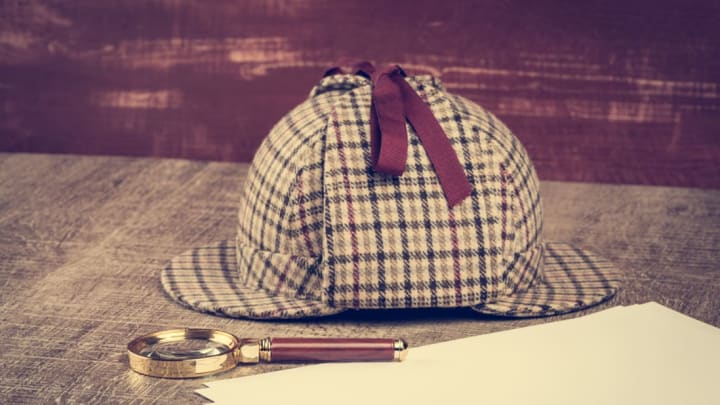Sun hats, floppy hats, baseball caps, bucket hats: It’s easy to guess where the names of these hats come from. But what about fedoras, trilbies, and other headwear we’re donning this days? For the origins of these hat words, we’ll have to have a look under the etymological bonnet.
1. BEANIE
The name of this wintertime warmer, first recorded in the 1940s, is a pet form of bean, early 20th-century American slang for head. The term probably originates in baseball lingo: a beanball is a pitch thrown at a batter’s head; the term then expanded to refer to the head in general. Many Canadians call this cap a tuque, from the French toque, which is the term used for a wide variety of brimless hats—nowadays usually the tall, white chef’s cap.
2. BERET
We may associate berets with Parisian fashionistas or U.S. Army Special Forces, but berets began on the heads of Basque peasants. The word, coming into English from French, ultimately goes back to the Latin birrus. A birrus wasn’t exactly a hat, though; it was a kind of a hooded cloak.
3. BOWLER
The bowler calls up Victorian London—and for good etymological reason. The hat might be named after Thomas and William Bowler, milliners who, in the 1850s, sought a patent for "improvements in hats and other coverings for the head." But bowl, related to the word ball, was once a word for various spherical things in English. And heads, last time we checked, are indeed round.
4. CLOCHE
The cloche hat, all the vogue among women in the Roaring ’20s, is often described as “bell-shaped.” That’s exactly what cloche means in French: bell. Cloche, in turn, is from the Latin for bell, clocca, which could mark the time of day, hence English’s clock.
5. DEERSTALKER
Most will know this hat for the head it sat on: Sherlock Holmes. His iconic hat, though, is properly called a deerstalker, a British term for a very stealthy hunter of, yes, deer. Sir Arthur Conan Doyle never put the hat on his detective’s head; that was the work of illustrator Sidney Paget, who outfitted Sherlock for sleuthing set in the country.
6. DERBY
Speaking of deer, many Americans will know the bowler hat as the derby. In 1780, the 12th Earl of Derby started an annual horserace near Epsom, England. Male spectators there, apparently, were known for sporting hats that came to be called derbies. Derby most likely means “deer village,” joining the Old English deor (deer) and the Scandinavian byr (“town”), also the root of bylaw. Derbies, of course, live not just on top of heads, but also in Louisville, Kentucky and roller rinks.
7. FEDORA
The fedora takes its name from a play, Fédora, which became popular in the U.S. in the 1880s. The drama, written by Victorien Sardou, features a Russian princess named Fédora Romanoff, notably played by the French actress Sarah Bernhardt. One story says Bernhardt donned this type of hat during performances of the play. The name Fédora is a variation on Theodora/Theodore, Greek for “gift of god.”
8. MORTARBOARD
Some hats are worn for fashion, some for function. Others are worn to mark special occasions, like the graduate’s mortarboard. The mortarboard resembles, as the Barnhart Dictionary of Etymology puts it, “a square mason’s board for carrying mortar,” that mixture used to bind bricks and stone. The hat has a long and venerable tradition, perhaps inspired by birettas, worn by certain Catholic clergy, a word that, like beret, also comes from the Latin birrus.
9. PORKPIE
Academics’ mortarboards aren’t the only caps named for their shape. The porkpie hat, with its flat top and short, full brim, apparently resembles a porkpie, a savory British dish.
10. SOMBRERO
Forget ceremony. What’s a hat, ultimately, for? Covering the head from the elements. Providing shade. The broad-brimmed sombrero, in design and derivation, reflects this. First referring to an umbrella in English, sombrero is based on the Spanish sombra, from the Latin subumbrare, “to shadow,” literally under (sub) the shadow (umbra). Somber also comes from this root.
11. TRILBY
Fedoras and trilbies have a lot in common. For one, these two soft felt hats are often confused. For another, they both get their names from literary characters. Trilby is the name of an 1894 novel, and protagonist, by George du Maurier. A London staging of the story had Trilby wearing the hat which is now her namesake. Du Maurier’s Trilby also gives us the character, and word, Svengali.
12. ZUCCHETTO
The Pope is a man of many hats, we could say. When giving his tall and pointy miter a rest, he dons a white skull-cap known as a zucchetto. This means “small gourd” in Italian, from zucca (pumpkin). Gourds, as we can imagine, resemble heads, but you probably don’t want to tell the Pope he’s pumpkin-headed.
